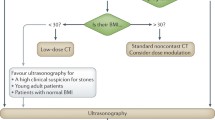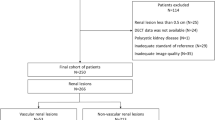Abstract
Purpose
To determine the sensitivity of portal venous phase contrast-enhanced CT for the detection of renal stones.
Methods
This retrospective study included 97 CT examinations of the abdomen without and with intravenous contrast, including 85 (87.6%) examinations with at least one renal stone on the “gold standard” noncontrast images, as scored by a single radiologist. Three other radiologists each independently reviewed only the contrast-enhanced images from all 97 examinations and recorded all renal stones. Reviewer sensitivity for stones was categorized by stone diameter. Reviewer sensitivity and specificity for stone disease were also calculated on a per-kidney basis.
Results
The 97 cases included a total of 238 stones ≥1 mm, with a mean (±SD) of 1.2 ± 1.9 stones per kidney and a stone diameter of 3.5 ± 3.0 mm. Pooling data for the three reviewers, sensitivity for all stones was 81%; sensitivity for stones ≥2, ≥3, ≥4, and ≥5 mm was 88%, 95%, 99%, and 98%, respectively. Sensitivity for stone disease on a per-kidney basis was 94% when considering all stones; when considering only stones ≥2, ≥3, and ≥4 mm, sensitivity was 96%, 99%, and 100%, respectively. Specificity for stone disease on a per-kidney basis was 98% overall, 99% when considering only stones ≥2 mm, and 100% when considering only stones ≥3 mm.
Conclusion
Contrast-enhanced CT is highly sensitive for the detection of renal stones ≥3 mm in diameter and less sensitive for smaller stones. In cases where the clinical diagnosis is uncertain and performance of a CT examination is being contemplated, intravenous contrast utilization would allow assessment for stone disease while also optimizing evaluation for other conditions.



Similar content being viewed by others
Reference
Kambadakone AR, Eisner BH, Catalano OA, Sahani DV (2010) New and evolving concepts in the imaging and management of urolithiasis: urologists’ perspective. Radiographics 30(3):603–623
Rosen MP, Siewert B, Sands DZ, et al. (2003) Value of abdominal CT in the emergency department for patients with abdominal pain. Eur Radiol 13(2):418–424
Abujudeh HH, Kaewlai R, McMahon PM, et al. (2011) Abdominopelvic CT increases diagnostic certainty and guide management decisions: a prospective investigation of 584 patients in a large academic medical center. AJR 196(2):238–243
American College of Radiology (2011) Acute onset flank pain—suspicion of stone disease. ACR Appropriateness Criteria®. http://www.acr.org/~/media/ACR/Documents/AppCriteria/Diagnostic/AcuteOnsetFlankPainSuspicionStoneDisease.pdf. Accessed 29 July 2013
Smith RC, Verga M, McCarthy S, Rosenfield AT (1996) Diagnosis of acute flank pain: value of unenhanced helical CT. AJR 166(1):97–101
Chen MY, Zagoria RJ, Saunders HS, Dyer RB (1999) Trends in the use of unenhanced helical CT for acute urinary colic. AJR 173:1447–1450
Tamm EP, Silverman PM, Shuman WP (2003) Evaluation of the patient with flank pain and possible ureteral calculus. Radiology 228(2):319–329
Dalrymple NC, Verga M, Anderson KR, et al. (1998) The value of unenhanced helical computerized tomography in the management of acute flank pain. J Urol 159:735–740
American College of Radiology (2013) Appropriateness criteria—diagnostic imaging topics. ACR Appropriateness Criteria®. http://www.acr.org/Quality-Safety/Appropriateness-Criteria/Diagnostic. Accessed 29 July 2013
Saunders H, Dyer R, Shifrin R, et al. (1995) The CT nephrogram: implications for evaluation of urinary tract disease. Radiographics 15:1069–1085
Cheng PM, Moin P, Dunn MD, Boswell WD, Duddalwar VA (2012) What the radiologist needs to know about urolithiasis: part 2–CT findings, reporting, and treatment. AJR 198(6):W548–W554
Smith RC, Verga M, Dalrymple N, McCarthy S, Rosenfield AT (1996) Acute ureteral obstruction: value of secondary signs on helical unenhanced CT. AJR 167:1109–1113
Heneghan JH, Dalrymple NC, Verga M, Rosenfield AT, Smith RC (1997) Soft-tissue “rim” sign in the diagnosis of ureteral calculi with use of unenhanced helical CT. Radiology 202:709–711
Furlan A, Federle MP, Yealy DM, Averch TD, Pealer K (2008) Nonobstructing renal stones on unenhanced CT: a real cause for renal colic? AJR 190:W125–W127
Andersson L, Sylvén M (1983) Small renal caliceal calculi as a cause of pain. J Urol 130:752–753
Brandt B, Ostri P, Lange P, Kvist Kristensen J (1993) Painful caliceal calculi. The treatment of small nonobstructing caliceal calculi in patients with symptoms. Scand J Urol Nephrol 27:75–76
Mee SL, Thuroff JW (1988) Small caliceal stones: is extracorporeal shock wave lithotripsy justified? J Urol 139:908–910
Brannen GE, Bush WH, Lewis GP (1986) Caliceal calculi. J Urol 135:1142–1145
Lau PC, Norman RW (1997) When is ESWL of small calyceal stones indicated? Can J Urol 4:413–415
Schiff SF, Dretler SP (1988) Extracorporeal shock wave lithotripsy. J Endourol 2:31–34
Jura YH, Lahey S, Eisner BH, Dretler SP (2013) Ureteroscopic treatment of patients with small, painful, non-obstructing renal stones: the small stone syndrome. Clin Nephrol 79(1):45–49
Sica GT (2006) Bias in research studies. Radiology 238(3):780–789
Memarsadeghi M, Schaefer-Prokop C, Prokop M, et al. (2007) Unenhanced MDCT in patients with suspected urinary stone disease: do coronal reformations improve diagnostic performance? AJR 189(2):W60–W64
Landis JR, Koch GG (1977) The measurement of observer agreement for categorical data. Biometrics 33(1):159–174
Kundel HL, Polansky M (2003) Measurement of observer agreement. Radiology 228(2):303–308
Coll DM, Varanelli MJ, Smith RC (2002) Relationship of spontaneous passage of ureteral calculi to stone size and location as revealed by unenhanced helical CT. AJR 178(1):101–103
Preminger GM, Tiselius HG, Assimos DG, et al. (2007) 2007 guideline for the management of ureteral calculi. J Urol 178(6):2418–2434
Rucker CM, Menias CO, Bhalla S (2004) Mimics of renal colic: alternative diagnoses at unenhanced helical CT. Radiographics 24(suppl 1):S11–S28
Krinsky G (1996) Unenhanced helical CT in patients with acute flank pain and renal infarction: the need for contrast material in selected cases. AJR 167:282–283
Talner L, Vaughan M (2003) Nonobstructive renal causes of flank pain: findings on noncontrast helical CT (CT KUB). Abdom Imaging 28:210–216
Dyer R, DiSantis DJ, McClennan BL (2008) Simplified imaging approach for evaluation of the solid renal mass in adults. Radiology 247:331–342
Spencer BA, Wood BJ, Dretler SP (2000) Helical CT and ureteral colic. Urol Clin N Am 27(2):231–241
Berkenblit R, Hoenig DM, Lerer D, Moses M, Minsky L (2013) Comparison of 0.625-mm source computed tomographic images versus 5-mm thick reconstructed images in the evaluation for renal calculi in at-risk patients. J Endourol 27(2):238–241
Bilezikian JP, Potts JT Jr, Fuleihan G-H, et al. (2002) Summary statement from a workshop on asymptomatic primary hyperparathyroidism: a perspective for the 21st century. J Clin Endocrinol Metab 87:5353–5361
McDonald RJ, McDonald JS, Bida JP, et al. (2013) Intravenous contrast material-induced nephropathy: causal or coincident phenomenon? Radiology 267(1):106–118
McDonald JS, McDonald RJ, Comin J, et al. (2013) Frequency of acute kidney injury following intravenous contrast medium administration: a systematic review and meta-analysis. Radiology 267(1):119–128
Davenport MS, Khalatbari S, Dillman JR, et al. (2013) Contrast material–induced nephrotoxicity and intravenous low-osmolality iodinated contrast material. Radiology 267(1):94–105
Newhouse JH, RoyChoudhury A (2013) Quantitating contrast medium-induced nephropathy: controlling the controls. Radiology 267(1):4–8
Amato E, Salamone I, Naso S, et al. (2013) Can contrast media increase organ doses in CT examinations? A clinical study. AJR 200:1288–1293
Acknowledgments
Funding for H.W.C.—This publication was supported in part by the CTSA Grant UL1RR025750, KL2RR025749, and TL1RR025748 from the National Center for Research Resources (NCRR), a component of the National Institutes of Health (NIH), and NIH roadmap for Medical Research. Its contents are solely the responsibility of the authors and do not necessarily represent the official view of the NCRR or NIH.
Author information
Authors and Affiliations
Corresponding author
Rights and permissions
About this article
Cite this article
Dym, R.J., Duncan, D.R., Spektor, M. et al. Renal stones on portal venous phase contrast-enhanced CT: does intravenous contrast interfere with detection?. Abdom Imaging 39, 526–532 (2014). https://doi.org/10.1007/s00261-014-0082-4
Published:
Issue Date:
DOI: https://doi.org/10.1007/s00261-014-0082-4




